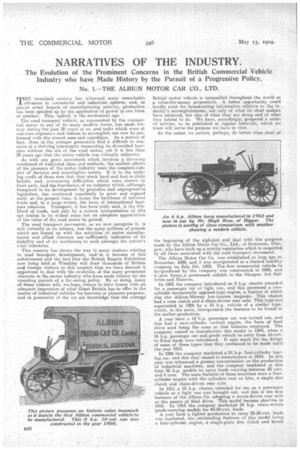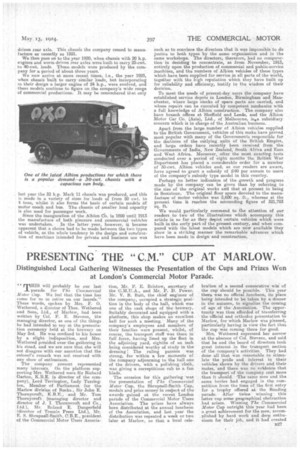NARRATIVES OF THE INDUSTRY.
Page 10

Page 11

If you've noticed an error in this article please click here to report it so we can fix it.
The Evolution of the Prominent Concerns in the British Commercial Vehicle Industry who have Made History by the Pursuit of a Progressive Policy.
No. 1.—THE ALBION MOTOR CAR CO., LTD.
riiHE twentieth century has witnessed many reraarkable .1 advances in commercial and industrial spheres, and, in almost every branch of manufacturing activity, production has been speeded up by the application of -power in one form or another. This, indeed, is the mechanical age.
The road transport vehicle, as represented by the commercial motor in any of its many modern forms, has made history during the past 20 years or so, and tasks which were at onetime expensive and tedious to accomplish can now be performed with the utmost ease and expedition. As a matter of fact, those of the younger generation find it difficult to conceive of a thriving community transacting its diversified business without the aid of the road motor, yet it is less than 30 years ago that the motor vehicle was virtually unknown.
As with any great movement which involves a throwing overboard of well-tried ideas and methods, the earliest efforts of the pioneers of the motor industry were the constant,stthject of derision and meaningless taunts. It is to the undying credit af these men that they etuck hard and fast to their beliefs, and, overcoming difficulties which were strewn in their path, laid the foundation of an industry which, although hampered in its development by prejudice and unprogressive legislation, has continued ceaselessly to grow and expand until, at the present time, it farms the backbone of national trade and, to a large extent, the basis of international business relations. Transport, it has been truly said, is the lifeblood of trade, and only by a correct interpretation of this apt truism in its widest sense can an adequate appreciation of the value of the road motor be gained.
The teed transport movement, as we now recognize it, is still virtually in its infancy, but the many millions of pounds which are bound up with the activities of motor manufacturers and allied concerns are-sufficiently indicative of its etability and of its worthiness to rank -amongst the nation's vital industries.
This country has shown the way in many matters relating to road transport development, an& it is because of this achievement and the fact that the British Empire Exhibition now being held at Wembley will draw thousands of British and foreign visitors to this country that we have deemed it opportune to deal with the evolution of the many prominent concerns in the motor industry who have made history by the unending pursuit of a far-seeing policy. By so doing, many of these visitors will, we hope, return to their homes with an adequate impression of what Great Britain has to offer in the matter of industrial vehicles for business or pleasure purposes, and in possession of the cer am n knowledge that the average
British motor vehicle is unequalled throughout the world as a value-for-money proposition. A better opportunity could hardly exist for broadcasting information relative to the industry's accomphshatents, not-only of what its chief makers have achieved, but also of what they are doing and of whatthey intend to do. We -have, accordingly; prepared a series of articles, to be published at regular intervals, which we trust will serve the purpose we have in view.
At the. outset we cannot, perhaps, do better than start at the beginning of the alphabet and deal with the progress made by the Albion Motor Car Co., Ltd.; of Seotstotni, Glasgow, who have built up a worthy reputation which is respected by all those associated with the road transport. movement-.
The Albion Motor Car Co. was established se long ago as December, 1899, and it was incorporated as a limited liability company on JUly 5th, 1902. The first commercial vehicle to be7produced by the company was constructed in 1900, and h. now forms,a permanent exhibit in the Glasgow Art Galleries -and Museum.
In 1901 the company introduced an 8 h.p. chassis intended for a passenger car or light vs-n, and this possessed a twocylinder horizontally opposed-type engine, a feature of which was :the Albion-Murray low-tension magneto. -This chassis bad a cone clutch and a chain-driven rear axle. This type was superseded in 1902 by a 10 h.p. vehicle of a similar type, which, in the main, incorporated the features to be found in the earlier production. A year later a 12.11.p. passenger car was turned out, and this had a twin-cylinder vertical engine, the form of final drive used being thesame as that hitherto employed. The company ceased to manufacture this model in 1904, when a. 16 h.p. passenger c.ar and goods vehicle to carry from 15-cwt. to 2-ton loads were introduced. It says much for the design of some of these types that. they continued to he made until the year 1915.
In 1906 the company marketed a 24 h.p. four-cylinder touring car, and this they ceased to manufacture in 1910. In this year was witnessed' a greater concentration on the production of industrial machines, and the company marketed at this time 32 h.p. models to carry loads varying between 50 cwt. and 4 tons. 'Me main features of these machines were a fourcylinder engine with the cylinders cast en bloc, a single disc clutch and chain-driven rear axle.
In 1911 a 15 h.p. chassis intended for use as a passenger vehicle or a light van was brought out, and this is the first instance of the Alllion Co. adopting a worm-driven rear axle as the means of final drive. This model became obsolete in 1915. In 1913 the company marketed 25 h.p. chain-driven goods-carrying models for 40-50-cwt. loads.
A year later a. lighter production to carry 25-30-cwt. loads was marketed, the outstanding features of this model being a four-cylinder engine, a single-plate disc clutch and bevel
driven rear axle. This chassis the company ceased to manufacture as tecently as 1921.
We then pass on to the year 1920, when chassis with 20 h.p. engines and worm-driven rear axles were built to carry 25-out. to 40-cwt.. loads. These models were produced by the company for a period of about three years.
We now arrive at more recent times i.e., the year 1023, when chassis built to carry similar loads, but incorporating in their design a larger engine of 24 h.p., were evolved, and these models continue to figure on the company!s wide range of commercial productions. It may be remembered that ordy last year the 32 hp. Mark 11 chassis was produced, and this is made in a variety of sizes for loads of from 50 cwt. to 4 tons, whilst it also forms the basis of certain models of motor coach and bus. The chassis of smaller load capacity is also used for passenger work. Since the inauguration of the Albion CO. in 11199 until 1913 the manufacture of both pleasure and commercial vehicles was undertaken. In the latter year, however, it became apparent that a choice had to be made between the two types of vehicle, as the whole tendency in the design and construction of machines intended for private and business uee was
such as to convince the directors that it was impossible to do justice to both types by the same organization and in the same workshops. The director's, therefore, had no compunction in deciding to concentiate, its 'from November, 1913, entirely upon the production of commercial and public-service machines, and the numbers of Albion vehicles of these types which have been supplied for service in all parts of the world, together with the 'high reputation which they have built up for reliability and efficiency, testify to the wisdom of their decision.
To meet the needs of present-day users the company have established service depots in London, Birmingham and Manchester, where large stocks of spare parts are carried, and where repairs can be executed by competent mechanics with a full knowledge of Albion construction. The company also have branch offices at Sheffield and Leeds, and the Albion Motor Car Co. (Asia), Ltd., of Melbourne, isea subsidiary concern which is in charge of the Australian business.
Apart from the large number of Albion vehicles supplied to the British Government, vehicles of this make have proved most popular with many of the Governments responsible for the destinies of the outlying units of the British Empire, and large, orders have recently been received from the -Governments of India, New Zealand, South Africa and East and West Africa. Moreover, after the most exacting tests conducted over a period of eight months the British War Department has placed a considerable order for a number of 30-cwt. Albion vehicles and, as our readers are aware, have agreed to grant a subsidy of 40 per annum to users of the company's subsidy type model in this country.
Perhaps no better indication of the growth and progress made by the company can be given than by referring to the size of the original works and that at present in being in Sootsthun. The original floor space devoted to the menufacture of motor vehicles was 3,600 sq. ft., whereas at the preseni time it reaches the astounding figure of 321,783 sq. ft.
We would particularly commend to the attention of our readers to two of the illustrations which accompany this article in so far as they depict 'certain vehicles which were built in the early part of the present century, and when compared with the latest models which are now available they show in a striking manner the remarkable advances which have been made in design and construction.




























